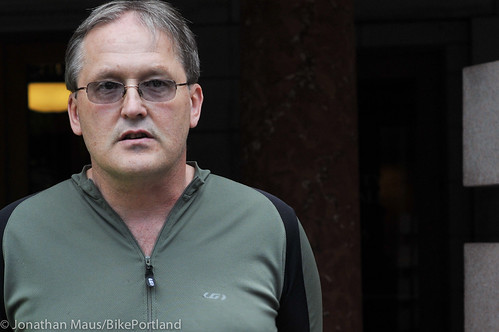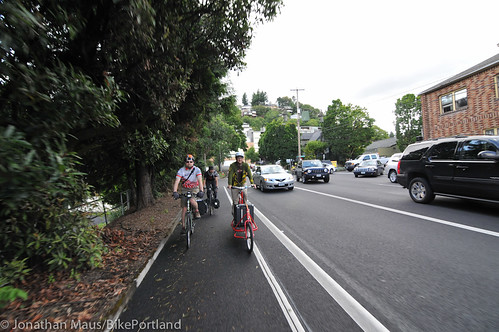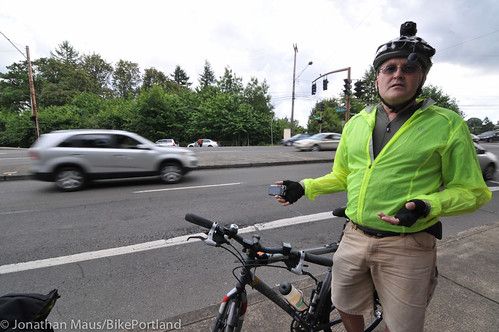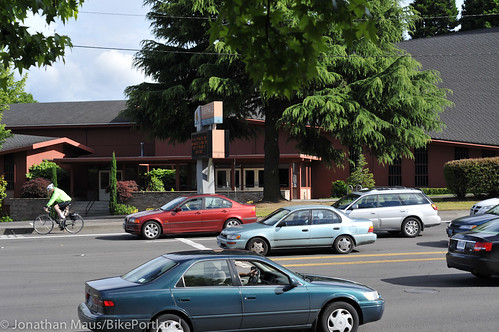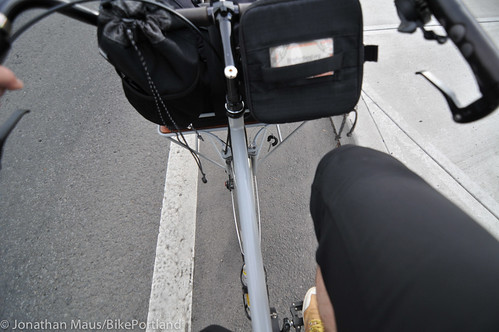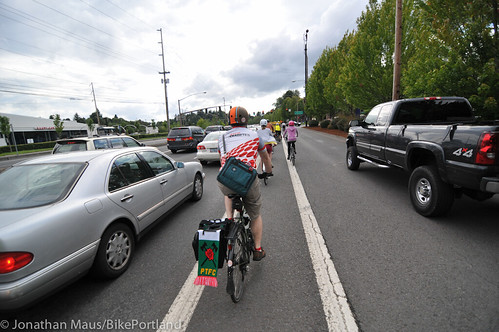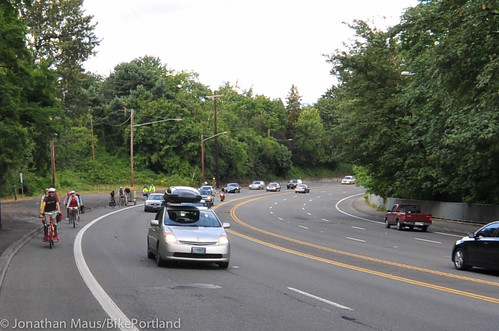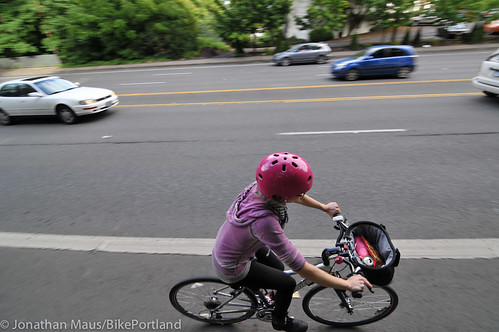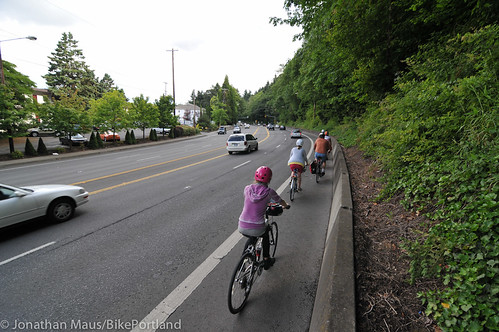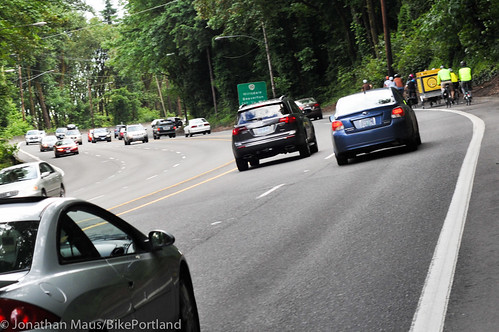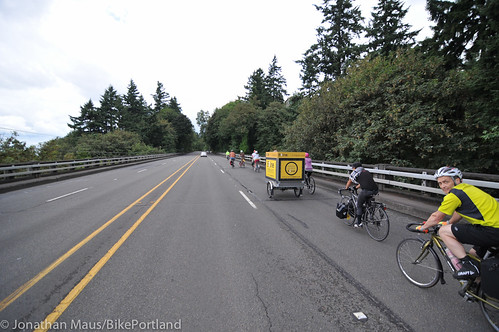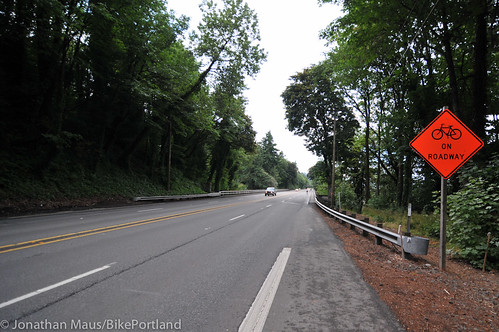
with the dangerous and outdated Barbur Blvd.
(Photos © J. Maus/BikePortland)
(NOTE: The headline of this story was originally, “When it comes to bicycling, SW Barbur Blvd is an embarrassment.” But after realizing that it’s just terrible and dangerous for everyone, I removed the bicycling part. — Jonathan)
Let’s be honest: SW Barbur Blvd, which is perfectly positioned to be the cycling conduit between southwest and downtown Portland, is a relic of traffic engineering. Its design is about five decades out-of-date and by lacking basic safe facilities for people on bicycles, it does not live up to the standards Portland prides itself on.
We’ve written about projects, plans, and tragedies on SW Barbur Blvd for years and have ridden on it several times. But Tuesday night, during the You Need A Better Barbur Pedalpalooza ride (and following two weeks in Copenhagen and the Netherlands where bicycles are a respected part of the traffic mix), it really hit me: Barbur is an embarrassment.
Tuesday’s ride was a collaboration between the Bicycle Transportation Alliance and Friends of Barbur. The description for the ride was: “Barbur Boulevard should be the best route to and from SW Portland. Right now, it’s scary. Learn how we can fix it.” Despite the dangers, a dozen or so people showed up. The BTA’s Carl Larson was in a super-bright, neon jacket. “I don’t usually wear bright yellow,” he said, “but then I rode on Barbur and realized you really do need extra visibility out there.”
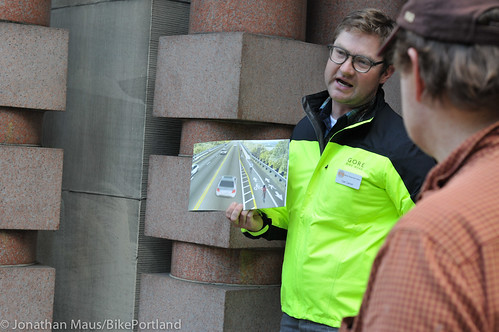
The people on the ride were a mix. One guy was a daily Barbur commuter who wanted to share his perspectives and gripes. One woman I met lives just a block or so away from SW Barbur yet had never ridden it before (it seemed too scary to ride alone so she drives instead). Super citizen activist Roger Averbeck was also with us. He has fought from within the system to make Barbur better for years. He’s got a list of small victories to show for it; but you can sense his growing frustration at the lack of real change.
One of — if not the — main reason change is slow in coming to Barbur is because it’s a state highway (99W). As such, it’s managed by the Oregon Department of Transportation (ODOT), an agency with a much more auto-centric way of doing business than the Portland Bureau of Transportation (PBOT). As Barbur begins just south of downtown Portland across I-405, we noticed some recent improvements such as sharrows and a new buffered bike lane. Those changes were done by PBOT because the close-in sections of Barbur are under their jurisdiction. But even the PBOT-managed sections aren’t anything to write home about. (A new buffered bike lane just south of Sheridan completely lacks bicycle symbols. The bike lane itself is just the standard, 5-6 foot stripe of paint and you ride just a few feet from people driving 40-50 miles per hour.)
At a stop on SW Hamilton, Averbeck warned, “We are now entering ODOT country.”
Beyond an agency culture that seems reluctant to move past the auto-dominated status-quo, ODOT has no good reason to not bolster bike facilities on Barbur. (Amazingly, one of ODOT’s responses to the road diet suggestion was that they might need Barbur in case it’s needed as an alternate to I-5.) As Averbeck pointed out on Tuesday, Barbur is classified as a “district highway” in the Oregon Highway Plan. That plan says the objective of a district highway is to (among other things), “provide for moderate to low-speed operation in urban and urbanizing areas for traffic flow and for pedestrian and bicycle movements.”
If you’ve ever ridden on Barbur, you know it doesn’t live up to those objectives.
One of the worst stretches is south of Hamilton, when Barbur curves into a wooded area dotted with apartment buildings as it heads toward SW Capitol Highway. To take the photos below, I stood at the exact same spot I visited the night Angela Burke was hit and killed by a speeding drunk driver back in 2010.
The ride also gave us a chance to ride over the bridges that go across SW Vermont and Newbury streets. A $5 million seismic rehab and repaving project for these bridges are what sparked a grassroots movement for a road diet. The BTA strongly endorses the idea, as do neighborhoods and citizen groups like Friends of Barbur. Even PBOT knows a road diet is needed and feasible at this location. As of today, ODOT has not endorsed the idea. Instead of the attractive and comfortable design envisioned by community advocates, they’ve offered feeble solutions like a slightly wider sidewalk and a flashing “Bikes on Bridge” sign.

Barbur could be a bicycle corridor with massive amounts of people riding on it to connect to downtown. The possible fixes are not rocket science: Re-allocate roadway space to make bicycling more comfortable; add design features that will encourage safer driving behaviors; increase speed enforcement via red-light cameras and speed reader boards; do more placemaking and encourage development that will add human life to the streetscape; and so on. Any solution that moves forward must put the bicycle facility on equal footing with the auto facility (or future transit facility) or we will never realize this road’s true potential and we will continue to put the health and safety of our community at risk.
Your move ODOT.
— Get involved with the effort to make Barbur Blvd better for bicycling. Like the Friends of Barbur Facebook page, get inspired by their vision for Barbur and stay tuned to the Front Page for developments.

